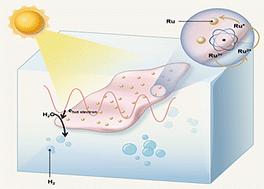Facile synthesis of Ru atom clusters on MXene nanosheets through gamma-ray radiation for plasma boosting hydrogen evolution reaction
IF 9.5
2区 材料科学
Q1 CHEMISTRY, PHYSICAL
引用次数: 0
Abstract
Water electrolysis with limited hydrogen yield is the main method for producing green hydrogen, which shows enhancement when coupled with solar energy. MXenes are one of the promising materials with an intensity localized surface plasmon resonance (LSPR) effect for the utilization of infrared and visible wavelengths of the solar spectrum. In this work, Ru atom clusters were anchored on Ti3C2Tx MXene nanosheets through gamma-ray radiation using hydrated electrons (eaq−) as the reducing agent and Ti3C2Tx itself as the oxidizing free radical scavenger to form Ru/Ti3C2Tx catalysts. The as-synthesized catalysts perform enhanced activity in the hydrogen evolution reaction (HER) across all pH ranges under 808 nm near infrared (NIR) light illumination because of the plasmonic effect of Ti3C2Tx nanosheets. Ru/Ti3C2Tx with only 2.40 wt% Ru exhibits the highest HER activity under NIR light illumination with a Tafel slope of 141 mV dec−1 and a current density enhancement of 3.56 mA cm−2 at an overpotential of 200 mV. This work demonstrates the effectiveness of gamma-ray radiation for synthesizing atomically dispersed electrocatalysts with enhanced HER performance when coupled with the illumination of infrared light.

用伽马射线辐射等离子体加速析氢反应在MXene纳米片上快速合成Ru原子团簇
有限产氢的水电解是生产绿色氢的主要方法,当与太阳能结合使用时,其效果会增强。MXenes是利用太阳光谱中红外和可见光波长具有强局域表面等离子体共振(LSPR)效应的材料之一。在这项工作中,Ru原子团簇以水合电子(aq -)作为还原剂,Ti3C2Tx本身作为氧化自由基清除剂,通过伽马射线将Ru原子团簇固定在Ti3C2Tx MXene纳米片上,形成Ru/Ti3C2Tx催化剂。由于Ti3C2Tx纳米片的等离子体效应,在808 nm近红外(NIR)光照下,合成的催化剂在所有pH范围内的析氢反应(HER)中表现出增强的活性。Ru/Ti3C2Tx在近红外光照射下表现出最高的HER活性,Tafel斜率为141 mV dec−1,过电位为200 mV时电流密度增强3.56 mA cm−2。这项工作证明了伽玛射线辐射与红外光照射相结合时合成具有增强HER性能的原子分散电催化剂的有效性。
本文章由计算机程序翻译,如有差异,请以英文原文为准。
求助全文
约1分钟内获得全文
求助全文
来源期刊

Journal of Materials Chemistry A
CHEMISTRY, PHYSICAL-ENERGY & FUELS
CiteScore
19.50
自引率
5.00%
发文量
1892
审稿时长
1.5 months
期刊介绍:
The Journal of Materials Chemistry A, B & C covers a wide range of high-quality studies in the field of materials chemistry, with each section focusing on specific applications of the materials studied. Journal of Materials Chemistry A emphasizes applications in energy and sustainability, including topics such as artificial photosynthesis, batteries, and fuel cells. Journal of Materials Chemistry B focuses on applications in biology and medicine, while Journal of Materials Chemistry C covers applications in optical, magnetic, and electronic devices. Example topic areas within the scope of Journal of Materials Chemistry A include catalysis, green/sustainable materials, sensors, and water treatment, among others.
 求助内容:
求助内容: 应助结果提醒方式:
应助结果提醒方式:


